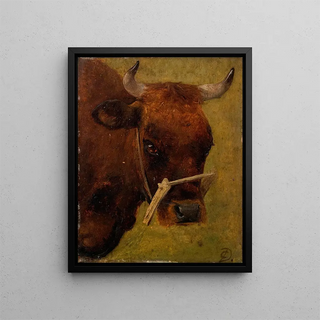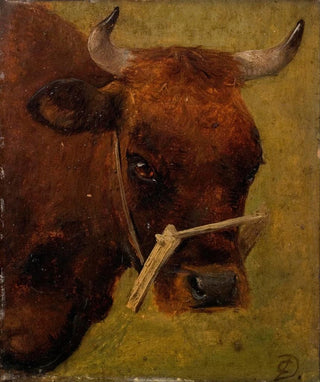Art print | Study of a cow's head - Carlo Dalgas Source: Reproduction | Étude de la tête d'une vache - Carlo Dalgas


View from behind

Frame (optional)
In the world of art, some works manage to transcend their simple representation to become profound reflections on nature and the animal condition. "Study of the Head of a Cow - Carlo Dalgas" perfectly fits into this tradition. This piece, both delicate and powerful, invites us to contemplate not only the beauty of the animal but also how it is perceived by the artist. Through this study, Dalgas captures the very essence of the cow, an animal often associated with rural life and simplicity, but which, in its representation, reveals an unsuspected complexity.
Style and uniqueness of the work
Carlo Dalgas's work stands out for its meticulous approach and attention to detail. Every line, every shade of color seems to have been chosen with care, demonstrating undeniable technical mastery. In this study, the cow is not just a subject but a protagonist, a figure that comes to life under the artist's brush. The features of the animal are rendered with precision that evokes both the softness of its fur and the quiet strength of its gaze. Dalgas manages to create an intimate, almost contemplative atmosphere, where the viewer is invited to get closer to this majestic creature. Light plays a crucial role in this piece, highlighting volumes and textures, and emphasizing the animal's natural beauty. This unique style, both realistic and imbued with poetry, makes this study a true masterpiece.
The artist and his influence
Carlo Dalgas is an artist whose journey deserves to be explored. Influenced by the great masters of animal painting, he has developed a style that is uniquely his own, blending tradition and modernity. His fascination with the animal world is reflected in each of his works, where he seeks to establish a dialogue between man and nature. Dalgas does not merely reproduce animals; he seeks to understand their essence, to capture their soul. This introspective approach has allowed him to carve out a prominent place in the contemporary artistic landscape. His work, often exhibited in galleries

Matte finish

View from behind

Frame (optional)
In the world of art, some works manage to transcend their simple representation to become profound reflections on nature and the animal condition. "Study of the Head of a Cow - Carlo Dalgas" perfectly fits into this tradition. This piece, both delicate and powerful, invites us to contemplate not only the beauty of the animal but also how it is perceived by the artist. Through this study, Dalgas captures the very essence of the cow, an animal often associated with rural life and simplicity, but which, in its representation, reveals an unsuspected complexity.
Style and uniqueness of the work
Carlo Dalgas's work stands out for its meticulous approach and attention to detail. Every line, every shade of color seems to have been chosen with care, demonstrating undeniable technical mastery. In this study, the cow is not just a subject but a protagonist, a figure that comes to life under the artist's brush. The features of the animal are rendered with precision that evokes both the softness of its fur and the quiet strength of its gaze. Dalgas manages to create an intimate, almost contemplative atmosphere, where the viewer is invited to get closer to this majestic creature. Light plays a crucial role in this piece, highlighting volumes and textures, and emphasizing the animal's natural beauty. This unique style, both realistic and imbued with poetry, makes this study a true masterpiece.
The artist and his influence
Carlo Dalgas is an artist whose journey deserves to be explored. Influenced by the great masters of animal painting, he has developed a style that is uniquely his own, blending tradition and modernity. His fascination with the animal world is reflected in each of his works, where he seeks to establish a dialogue between man and nature. Dalgas does not merely reproduce animals; he seeks to understand their essence, to capture their soul. This introspective approach has allowed him to carve out a prominent place in the contemporary artistic landscape. His work, often exhibited in galleries






